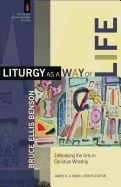Today we have Bruce Ellis Benson’s response to Linda Borecki’s very provocative and stimulating set of questions from her review of his book Liturgy as a Way of Life. Bruce’s response is equally as captivating. 
**Please take the time to join in this Symposium by reflecting with us in the comments below. These reviews and responses really do extend the conversation of the book and YOU get a chance to interact with the author here. Bruce and the reviewers are ready and willing to engage with you in the comments. Don’t hesitate to jump in!
——
Many thanks to Linda Borecki for such a good set of questions! Linda mentions the similarities between my book and the book of Harold Best (Unceasing Worship: Biblical Perspectives on Worship and the Arts). Harold was a colleague of mine during roughly the first decade that I taught at Wheaton and we discussed many of these issues over the years. So that similarity is hardly surprising—and fits very well with the basic improvisation thesis for which I’m advocating.
Let me provide some answers to her questions, albeit answers that will continue the conversation rather than end it.
When I use the word “improvisation,” I don’t mean something equivalent to “spontaneity.” In fact, I use “improvisation” to mean the opposite of spontaneous creation. Put in other words, I argue that improvisation is never “creatio ex nihilo.” We improvise when we work with that which already exists. Similarly, God improvises when he works with what already exists. In other words, if God is at work in the world at this moment, he is working with what already exists. That thesis doesn’t entail God either knowing the future or not knowing the future—that’s another question.
By and large, I believe that evangelicals are becoming more incarnational not just in their thinking (!) but also in their practice. Of course, it’s hard to know exactly which drives which on something like this. It is Aristotle who first makes the distinction between theory and practice. Whatever else “postmodernity” is, it is certainly the questioning of whether this distinction really makes sense. You mention evangelicals who are embracing more incarnational worship practices, but I think there is a larger move among evangelicals toward taking the incarnation seriously both in theology and worship. Although it’s purely anecdotal, I have seen this change in my students over the years of teaching. Of course, I say that with the caveat that evangelicals are still significantly influenced by the dualisms of Plato. You ask how those who embrace the arts and see baptism and the Lord’s Supper in a more incarnational way will influence “the future of North American Christian Worship.” I think we are slowly seeing a change in how evangelicals treat the arts and how they treat these ordinances/sacraments (I will simply pass over the implications of the terminology): namely, they are being taken more seriously as important ways in which we relate to God and others in the Christian community.
There is certainly space in worship for the whole range of human experience! Just look at the diversity range of the Psalms. Laments did not result in a disavowing of God’s existence: they resulted in increased faithfulness. So, although people may experience that which they may find incongruent with the God they think they know, the solution is neither to ignore that experience nor to give up hope. Solace is frequently found in lament. Calling out to God in faith and trusting in him may be cathartic, but we do not go to church on Sunday to fulfill our emotional edification. This is the sentimentality in worship, as well as a blatant misrepresentation. Manipulation of the emotions of the gathered community by music played during prayer, for example, is indeed very common, but that cannot mean that art can’t be used in a life-giving, God-honoring way.
In my experience, beauty is the quality of that which points beyond itself. Thus, the beautiful is the icon. That makes Jesus the beauty of God, and I like that definition. It inspires hope and excitement at the prospect of worshiping God with art as humans made in his image. But there is a complication here: we live in a world that is not fully beautiful—or, to put it in one way, we experience a “broken beauty.” I think evangelicals are quick to seize on that which is harmonious and ignore or downplay the aspects of our lives (and those of others) that are disharmonious.
Listening is most importantly understood as a Gadamerian willingness to be put into question. This, I have found, is both very difficult and very rewarding. You ask how I have been transformed by beauty. The simple answer is: every day in many ways! I find that beauty inspires, transforms, puts me into question, and also affirms. But this requires learning to listen! One way of defining “listening” is that it is both refraining from speaking and also from thinking of what we are going to say in response once we get the chance to speak. It is giving ourselves over to the one who is speaking. Gadamer reminds us that a genuine conversation is one in which we don’t know the outcome! That is a lesson that I learn every day.